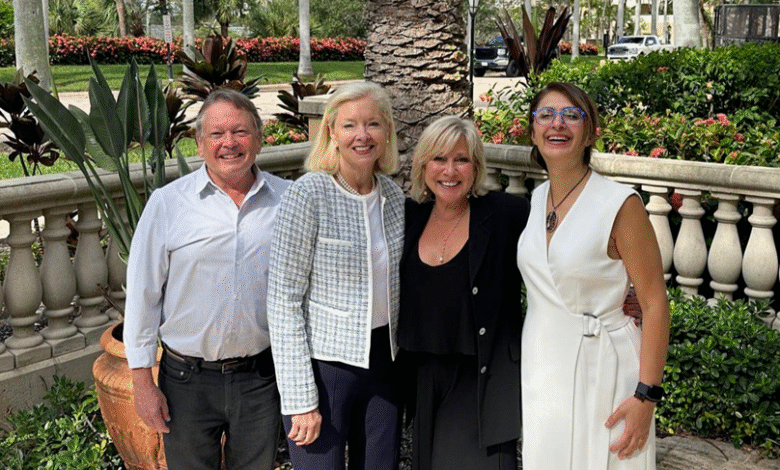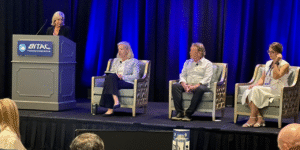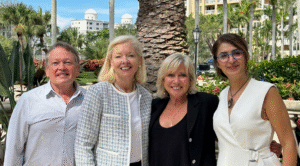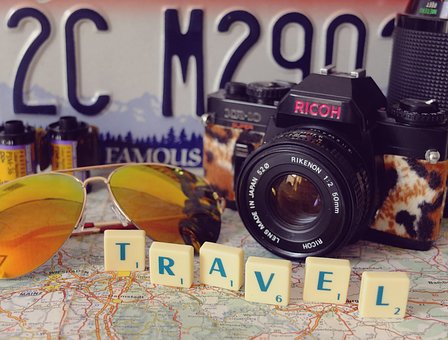
BITAC Purchasing & Design Summer 2025 Panel: Designing for the Guest Experience, Part 1
By Jim Nelson | November 4, 2025
Hotel Interactive, in conjunction with sister company BITAC, holds executive events throughout the year, including our annual summer Purchasing & Design executive event. This event is where hospitality executives all across the nation come to build relationships and learn more about the profession.

“Designing for the Guest Experience,” one of the panels at this Purchasing & Design event, was moderated by Brenda Amsberry, the principal and senior interior design director for OLC (Architecture | Interiors | Aquatics). Her panelists were Cara Hall, principal at GH2 Architects; Todd Voelker, president/owner of Voelker Gray Design and T S Voelker Architecture; and Vanisa Saffari, principal and interior designer at Porada Design Group.
Amsberry began by spotlighting the opportunity that designers have to foster community in hospitality spaces, bridging post-COVID disconnects to create environments that unite rather than isolate guests. She explained that the panel would address how several things play into their design process, beginning with the brands.
BRENDA AMSBERRY: Obviously, the brands have a huge influence over what we’re able to do, depending on the level of brand and whether select or luxury. Cara, talk about what you are experiencing with the brands and how it influences how you design.
CARA HALL: I think one of the things that we’re all experiencing is the sheer number of brands and the brand standards, and the overlap between the brands. Really understanding what that distinction is in each of the brands has become a lot more critical; even though maybe we perceive some overlap, they often do not. So, really being able to give a sense of place as well as meet the brand standards; trying to do those things and still meet your owner’s needs as well as the brand needs. And the one thing I’m commonly getting — not from the brand, but from the owner — when we have one of our first design meetings, is “What’s my Instagrammable moment?”

TODD VOELKER: People want to feel that they’re in a place that makes them feel good. And what does that mean? That’s the question: How do we create places where people, when they think back on it, “I felt really good when I was there”? What were the things that helped them to have that experience? There’s a tendency now that we want to create things that are unique and special. We touched on that yesterday a little bit, about the cultural aspects and how that influences design; also it’s about understanding and being responsive to the actual climate conditions of where you are, because that creates architecture that’s very different, no matter where you are. Here, we’re in tropical land, it seems like with never-ending rain, but that influences the architecture. So, the danger is when you create prototypes, and all of the major brands do that, how does that prototype adapt to each of the individual locations? Sometimes it works well; often, in my opinion, it falls short and I think that there needs to be more of an infrastructure that allows for a bit more variation, especially in the common areas and where you can open to the outside when it’s appropriate. Of course, these days, with health and wellness, people want the fresh air, even if it’s hot outside or even if it’s freezing; they feel safer when there’s a sense that you’re not locked in. So, how do you do that? It’s challenging, but it can be very interesting. You invent a prototype that is more adaptable.
VANISA SAFFARI: I agree with both of you. The consistency is amazing to have, but as you guys are saying, when you wake up and you open your eyes, you don’t want to have a sticky note next to your bed saying, “I am in Athens,” for example. You want to be able to have some kind of a touch of the culture, of the context, let’s say, to bring all together and you feel safe and comfortable, because we are expecting to have comfort in our guest room.
BA: Speaking of comfort, another topic we discussed is wellness; at OLC, we are all about wellness. We stay well, get well, be well; the staying well is part of the hospitality, and incorporating wellness into hospitality involves creating different experiences and opportunities for the guests. One thing I really found interesting was something that Todd is doing right now.

TV: It’s really interesting, what’s going on culturally. I think the younger generations are not in a good place. There’s a sense of isolation, a sense of lack of connection. I think our cell phones are beautiful things, but they have become something not so beautiful; the youngest generation now is the loneliest, most depressed generation we’ve ever had, and that’s statistically true. We do a lot of work in the spa industry and health and wellness as well, and we’re trying to develop programs that are encouraging people to come together and to meet, and it’s not as simple as a meeting room or a lobby where you meet and have drinks, but within the spa programs to develop ideas that are really fun, that really encourage you to get involved and not just go to the spa; it’s a social spa experience. What does that mean? We invent treatments that are fun, kind of silly, kind of goofy. We try and get people to have fun, get together. John Gray is one of my business partners from Voelker/Gray — he’s a founder of Glen Ivy Hot Springs, and he’s brilliant. We have so much fun. We invented an element where it’s like a mass production treatment. Instead of individual treatment rooms where you get a body wrap, we go into an elevator — it feels like you’re going way down into a chamber, so it’s sort of theatric but you’re really not that far underground and you’re in a hot chamber — and they paint you with the same solution that you would get in a body wrap treatment sitting in the hot room, and you get the same benefit for that, in a mass production. You’re all together with your friends, giggling, laughing, taking photos. So, it becomes an experience. That’s just an example of trying to think creatively; how do we apply that to the restaurants? How do we apply that to other things within the typical elements that you offer?
VS: Thinking about having, let’s say, sunset yoga on a rooftop; the young generation, they’re all rushing to take pictures to get the best Instagram shot, when the older crowds there are trying to get their best poses. So, these kind of things, all salt rooms, I guess the sauna, that’s a great thing, because if you’re sitting in a sauna, how long can you keep quiet and stay silent? Creating the environment and the spaces in hotels, I think, is the best option to bring all the generations together — the grandparents, the baby boomers, the grandchildren.
CH: What we are primarily focusing on is the architecture and design, how it reacts; we’re doing meeting rooms now that have windows all the time; we work with meeting planners to talk with them about what the sales points are, what people who are booking meetings want, and that’s natural light, good ventilation, outdoor spaces, and a connection with the outdoors. So, we’re trying to do that in every space of the hotel, not just in the guest rooms or the corridor in the pre-function space, but bringing it into meeting rooms, to spa treatment rooms, to guest rooms, to corridors. And let’s not forget the back of house; one of your greatest assets as an owner are your employees and your staff, so we try to bring some of those nice design elements that we give to our guests to the back of house, too.
In part 2 of this article, the panelists will dive into some innovative guest experiences, challenges with project timelines, and supply chain delays, emphasizing the need for authentic community-building and creative design to foster belonging, well-being, and playful engagement for both guests and staff.






Get involved!
Comments